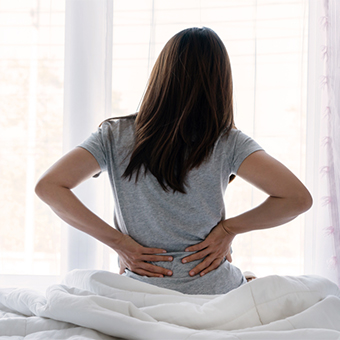Everyone has heard since childhood the benefits of sleeping on a hard surface for back health, but few people know what situations are meant and what kind of rigidity is really implied in this statement. Many people are sure that with back or lower back pain, you need not a hard mattress at all, but moving to the floor to sleep. And there are quite a lot of fans of such a radical theory. Let’s figure out whether such a spartan dream is really beneficial, whether it can be used to improve well-being or at least prevention.
Hard Mattress: Pros And Cons
Let’s start with a situation where there are no pronounced back problems and any diagnosis, the weight does not exceed the permissible weight (make sure of this by calculating your body mass index), and back pain is short and unsystematized, but there is some discomfort in the morning. This may well be due to insufficient body support and low orthopedics of the mattress used. The spine and muscles are not unloaded during sleep. Switching to a firmer mattress or foam mattress can help here.
Modern mattresses have five degrees of support: soft, moderately soft, medium, moderately firm and firm. With the choice of the most firm mattresses, you should be careful, as they have the most intense effect on the back, but are not too comfortable for soft tissues and blood vessels.
Pros And Cons Of Firm Mattresses:
Pros
- Spine Support
- Prevention of lower back deflection
- Recommended for moderate back pain
Cons
- Pressure on the joints (especially for thin people)
- Circulatory disorders
- Shoulder/hip discomfort
To start prevention, it makes sense to consider orthopedic mattresses with medium to moderately high firmness, there are a number of reasons for this:
An abrupt and significant change in the usual is always uncomfortable and requires longer getting used to.
For effective rest on a hard mattress, the habit of sleeping on your back, and not on your side or stomach, is desirable.
High Firmness Is Not Suitable For The Elderly.
What Orthopedic Scientific Research Says
Spanish scientists conducted an impact study in 2003, where they investigated the relationship between sleeping on mattresses of different firmness and improving well-being in non-specific low back pain on a group of more than three hundred people.
The foundation’s research showed that after 90 days, the results were distributed as follows:
1. Medium firm mattresses or foam mattress reduce pain by 48%.
2. Too rigid – only by 28%.
Similar studies were conducted at different times and in different countries. The most interesting study was published in the specialized European journal of spinal health Spine Journal on the effect of stiffness of the sleeping surface on back health in the long term for more than 10 years. Its results were given in the issue for 2024. The study was conducted on a group of 1,200 adults between the ages of 30 and 50.
Scientists also concluded that sleeping on medium-hard mattresses is 23% deeper, but the frequency of awakenings is reduced by 18%. This is due to greater comfort and adaptability when changing body position.
Who Are Mattresses Of Increased Firmness Suitable For?
Despite the fact that medium firmness is more versatile, comfortable and 8 out of 10 orthopedists advise this stiffness to adults. There are situations when reinforced support and high rigidity are required:
Overweight people (BMI ≥35). With a weight of >120 kg, soft mattresses or foam mattress provoke:
- Spinal deflection > 4 cm.
- Risk of pinched nerves ↑ 2.8 times.
Professional athletes (strength sports). Data cited in the journal Sports Medicine, 2022 indicated that sleeping on firm mattresses prevents unnatural bends in hypertrophic back muscles and cited the following findings in weightlifters/wrestlers:
- Hard mattresses or orthopedic mattress ↓ 41% risk of microtrauma to the ligaments.
- Improve muscle recovery after exertion.
Adolescents in the period of active growth from 14 to 18 years old. Moderately hard surfaces, together with orthopedic ones, correct posture 42% more effectively and reduce the likelihood of negative consequences of “gadget mania”. According to recent studies, teenagers who regularly use their phones for more than 4 hours a day:
- Thoracic kyphosis is amplified by 28% due to a hunched posture behind phones.
- Cervical lordosis is smoothed out in 63% (according to the medical journal J Pediatr Orthop, 2023).
Ankylosing spondylitis. A study published in the Journal of Rheumatology in 2023 recommended hard surfaces due to the following effects:
- Reduce night pain by 53%.
- Slow down the fusion of the vertebrae by 29%.
- Consultation with a doctor is required.
Children with progressive scoliosis (II-III stages). Only as prescribed by an orthopedist, moderately rigid sleeping surfaces and a corset are used to correct the Cobb angle by 5-7° per year.
Who Is Not Recommended To Sleep On A Hard Mattress
- People older: 55 years old.
- Pregnant women: especially after 6 months.
- In osteoporosis: risk of compression fractures ↑ 89%.
- In diabetic neuropathy: risk of pressure ulcers ↑ 5x.
- In rheumatoid arthritis: morning stiffness > 90 min.
- In the postoperative periods: the rigid surface prevents the displacement of implants or vertebrae and minimizes movement in the fracture area, which accelerates healing.
- In case of circulatory disorders and venous diseases (varicose veins, thrombophlebitis, chronic venous insufficiency), hard mattresses are completely contraindicated.
- In hernias and protrusions: The pressure on the damaged spinal disc increases by 55% and the risk of nerve entrapment increases by 2-3 times.
Underweight thinness (BMI <22): Lack of body fat when sleeping on a hard surface leads to: 1) Excess pressure on the ischial tuberosity and greater trochanters ↑ by 85% (data from the Journal of Biomechanics, 2023). 2) Risk of painful bruising and numbness of the limbs.
How To Choose The Right Mattress Firmness
Body weight is not an objective indicator that determines the weight norm, since it does not take into account height. Correctly focus on the body mass index, you can calculate it using the formula below. People with different BMIs feel stiffness and its impact on their well-being in different ways.
Is It Possible To Sleep Directly On The Floor?
You can sleep on the floor for a short time and only with the use of a layer of at least a few blankets. If this is a forced one-time measure, then there will be no harm. Important: Do not exceed the period of sleep on the floor for more than 2-3 weeks in a row without medical supervision.
5 Reasons To Avoid Sleeping On A Bare Floor:
- Undercooling
- The floor takes body heat 30% faster than the bed.
- Risk of muscle/joint inflammation (especially in drafts).
- Increased Pressure On Bones And Joints
The ischial tuberosity and shoulders experience pressure up to 80 mmHg (with a norm of <32 mmHg).
Morning numbness of the limbs in 68% of people (data from the Journal of Sleep Research, 2023).
Lack Of Spinal Support
The lower back “sticks” to the floor → unnatural flattening of lordosis.
With scoliosis, the curvature can worsen by 5-10% in 3 months.
Dust And Allergens
There are 3 times more dust mites on the floor than at a height of 50 cm (data ◦ ◦ Allergy & Immunology, 2022).
Insects And Moisture
- In private homes, there is a risk of spider/bedbug bites.
- Fungus can live on the floor in high humidity.







